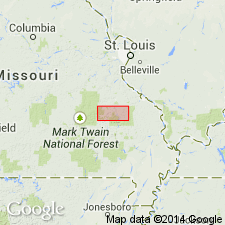
- Usage in publication:
-
- Anderson Mountain member [informal?]
- Modifications:
-
- First used
- Dominant lithology:
-
- Tuff
- Breccia
- AAPG geologic province:
-
- Midcontinent region
Summary:
Anderson Mountain member [informal?] of Lake Killarney formation. A coarse fragmental tuff and coarse breccia in uppermost part of Lake Killarney. Not separately mapped; Lake Killarney mapped in area between Ironton, Iron County, and Roselle, Madison County, St. Francois Mountains, southeastern Missouri (Midcontinent region). Unit probably represents slumped material from wall of Butler Hill caldera. Is mostly unsorted and unstratified, but does exhibit crude bedding in one outcrop. Tuff consists of a fine-grained matrix of quartz and feldspar with larger crystal fragments of quartz and perthite. Breccia consists of rounded to angular clasts of silicic volcanic rocks in a fine quartzo-feldspathic matrix; clasts make up 25 to 75 percent of rock and range from a few mm to 30 cm in diameter. Older than Grassy Mountain ignimbrite. Age is Proterozoic; most volcanic rocks of St. Francois Mountains are 1,485 Ma. Report includes geologic map, table of stratigraphic units.
Type locality not designated. Origin of name not stated by authors.
[Authors' intentions are unclear as to which, if any, of the geologic units discussed should have formal status.]
Source: Modified from GNU records (USGS DDS-6; Denver GNULEX).
For more information, please contact Nancy Stamm, Geologic Names Committee Secretary.
Asterisk (*) indicates published by U.S. Geological Survey authors.
"No current usage" (†) implies that a name has been abandoned or has fallen into disuse. Former usage and, if known, replacement name given in parentheses ( ).
Slash (/) indicates name conflicts with nomenclatural guidelines (CSN, 1933; ACSN, 1961, 1970; NACSN, 1983, 2005, 2021). May be explained within brackets ([ ]).

